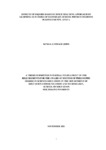| dc.description.abstract | The present study was inspired by the consistent posting of dismal performance in Physics in the Kenya as depicted in the annual KNEC report on KCSE performance for the duration 2014-2019. The same trend was observed for Kitui County. The study set out to investigate the effect of IBISTA on learning outcomes of secondary school physics students in Kitui County, Kenya. The guiding objectives were: to determine the difference in task competence between Physics students taught using IBSTA and those taught using conventional methods; to assess the variation in self-concept of students taught using IBSTA and those taught using conventional methods; to establish the difference in scientific-creativity of students taught using IBSTA and those taught using conventional methods and to determine the difference in motivation between students taught using IBSTA and those taught using conventional methods. The study was guided by two theories Constructivist and the Self-Determination Theory. It adapted a mixed methodology and a Quasi Experimental Research Design and in particular the Solomon‟s Four Non-Equivalent Control Group Research Design. The target population was 1600 form four students from 40 Extra-County Secondary Schools in Kitui County. Stratified random sampling was used to select four Extra-County schools. Purposive sampling was used to select 40 Form Four Physics students from each of the four schools and 2 Physics teacher from each of the 4 sampled schools, giving a sample size of 162 respondents. The study employed a Physics Task Competence Test, Students‟ Questionnaires, and Scientific Creativity Observation Schedule as the research tools. The research instruments were pilot-tested in two Extra-County schools in the neighbouring Machakos County to ascertain their validity and reliability. For reliability, test retest method was used, and computed using Kuder-Richardson formulae and the reliability of both the students‟ motivation questionnaire, students‟ self-concept questionnaire and the scientific observation schedule was obtained using Cronbach‟s Coefficient Alpha. A reliability coefficient average of at least 0.8124 was obtained. Descriptive analysis used frequencies, means, standard deviation and percentage while the inferential analysis used the t-test, Analysis of Variance, Chi-square and the Least Significant Difference (LSD) technique with the aid of Statistical Package for Social Science (SPSS) programme version 24. The hypotheses of the study were tested at α=0.05 level significance. The findings showed a statistically significant difference in the learning outcomes of students exposed to IBSTA compared to those taught by conventional methods. Statistical significance was reported in students‟ self-concept and out of the four indicators of self-concept, only role performance was not statistically significant. The findings also indicated that achievement goal, as one of the four indicators of motivation was not statistically significant. The study concluded that IBSTA is effective in improving students‟ learning outcomes. Finally, the study makes recommendations to the various education stakeholders, key among them being the creation of an environment for IBSTA adoption in schools. | en_US |

